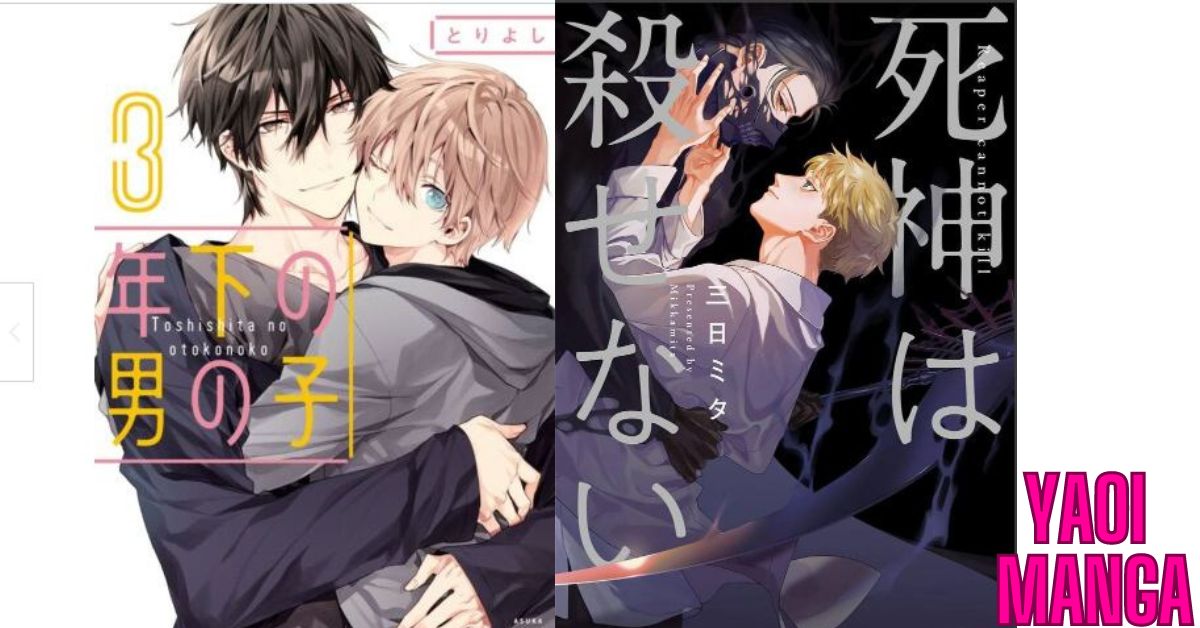Welcome to the captivating world of Yaoi Manga! Whether you are a seasoned fan or a curious newcomer, this comprehensive guide takes you on an exciting journey through boys’ love. Brace yourself for heartfelt romances, intricate storylines, and stunning artwork that will leave you wanting more.
Yaoi Manga has become a global sensation, captivating readers with its beautifully crafted tales of love between male characters. In this blog post, we’ll delve into the rich history and evolution of Yaoi Manga, explore its various subgenres and tropes, discuss issues surrounding representation and diversity within the genre, and even address some controversies that have arisen over time.
So grab your favourite beverage, find a cosy spot to settle in, and prepare to be enthralled by everything there is to know about Yaoi Manga. Let’s dive right in!
Contents
Understanding Yaoi Manga

Yaoi Manga, also known as boys’ love or BL, is a genre of manga that focuses on romantic relationships between male characters. It originated in Japan and has gained immense popularity worldwide. While it primarily caters to a female audience, people of all genders can enjoy the captivating stories and artistry within its pages.
What sets Yaoi Manga apart from other genres is its exploration of emotional connections and often explicit romantic encounters between male leads. These stories delve into love, desire, friendship, and personal growth themes. The intricate character development and compelling narratives make for an immersive reading experience.
It’s important to note that Yaoi Manga should not be confused with gay romance literature or real-life LGBTQ+ experiences. Rather than being representative of actual queer relationships, it serves as a form of entertainment that offers escapism into fictional worlds where anything is possible.
The artwork in Yaoi Manga ranges from delicate and ethereal to bold and dynamic. Artists skillfully depict the emotions shared between characters through their expressive facial expressions, body language, and meticulously detailed backgrounds. This attention to detail adds depth to the storytelling process.
While some may argue that Yaoi Manga perpetuates certain stereotypes or fetishizes same-sex relationships for heterosexual consumption, it’s crucial to approach this genre with an open mind while acknowledging the diverse range of stories available within it. Like any media form, both exceptional works challenge boundaries and those that fall into predictable tropes.
In the next sections of this guide, we will explore further aspects such as the history and evolution of Yaoi Manga and its various subgenres – so keep your eyes peeled! Whether you’re new to this enchanting world or already have one foot firmly planted in Yuriyama Land (a figurative term used by fans), there’s always something exciting waiting around every page-turning corner!
The History and Evolution of Yaoi Manga
Yaoi manga, also known as Boys’ Love or BL, has a rich history that spans several decades. Its origins can be traced back to the late 1960s and early 1970s in Japan. During this time, female shonen manga fans (manga targeted towards young boys) began creating their doujinshi (self-published works) featuring romantic relationships between male characters.
These early Yaoi stories often depicted taboo relationships and explored themes of forbidden love. They were primarily created by and for women who found solace in these narratives that challenged societal norms and expectations.
As Yaoi gained popularity, it started evolving into a genre with its distinct characteristics. In the 1980s and 1990s, influential artists like Takemiya Keiko and Yamane Ayano helped shape the genre by introducing more nuanced storytelling techniques and diverse character archetypes.
The advent of the internet further propelled the growth of yaoi manga. Online communities provide a platform for fans to share their creations, discuss their favourite works, and connect with like-minded individuals worldwide.
Today, yaoi manga continues to evolve with each passing year. It encompasses many subgenres, such as historical settings (e.g., samurai or Victorian era), fantasy worlds (e.g., vampires or demons), workplace romances, sports-themed stories, etc.
As society becomes more accepting of diverse sexual orientations and identities, Yaoi has become increasingly inclusive. The genre now features not only cisgender gay men but also transgender characters as well as non-binary individuals.
There is an undeniable cultural significance surrounding Yaoi manga – it has given voice to marginalized communities within Japanese society while offering readers an escape into fictional realms where love knows no bounds. Whether you’re new to Yaoi or have been a fan for years already – there’s always something new and exciting to discover in this ever-evolving genre.
Subgenres within Yaoi Manga
Yaoi manga is a diverse genre that offers a multitude of subgenres to cater to various tastes and preferences. These subgenres add depth and variety to the world of Yaoi, allowing readers to explore different themes and storylines.
One popular subgenre is “BL” or “Boys’ Love,” which focuses on romantic relationships between male characters. BL manga often depicts love stories with emotional intensity, exploring the complexities of same-sex relationships in realistic and fantastical settings.
Another intriguing subgenre is “Omegaverse,” which introduces an alternate universe where individuals are classified into alpha, beta, or omega roles based on their dominant characteristics. This dynamic creates power imbalances that lead to intense drama and romance between characters.
For those seeking more supernatural elements, there’s “Fantasy Yaoi.” This subgenre combines Yaoi with fantasy elements such as magic, mythical creatures, and otherworldly realms. It adds an exciting twist to traditional Yaoi narratives by incorporating fantastical adventures into the romantic plotlines.
If you enjoy historical settings, “Historical Yaoi” might be your tea. This subgenre transports readers to explore forbidden romances against historical backgrounds like feudal Japan or Victorian England. The clash between societal norms and burgeoning desires adds tension and intrigue to these captivating tales.
Fans of action-packed stories will find solace in “Yakuza Yaoi.” This gritty subgenre delves into the underworld of organized crime while intertwining passionate relationships amidst violence and danger. These gripping narratives showcase loyalty tested by treacherous circumstances.
These are just a few examples among many other fascinating subgenres within yaoi manga. Each offers a unique blend of storytelling elements that captivates newcomers and seasoned fans. So dive into this vast world full of possibilities – there’s something for everyone!
Common Tropes and Themes in Yaoi Manga
- Yaoi manga is known for its wide range of tropes and themes that captivate readers from all walks of life. These common elements add depth to the stories, creating a unique reading experience. Let’s explore some of Yaoi manga’s most popular tropes and themes!
- One prevalent trope is the “forbidden love” theme, where characters are drawn to each other despite societal or personal barriers. This can include relationships between student and teacher, boss and employee, or rival gang members.
- Another frequently seen trope is the “opposites attract” dynamic, where characters with contrasting personalities or backgrounds are irresistibly drawn together. This often leads to intense emotional conflicts as they navigate their differences.
- Power dynamics play a significant role in many Yaoi manga stories. Whether it’s a power imbalance due to age or social status, these dynamics create tension and heighten romantic encounters.
- Gender exploration is another recurring theme within Yaoi manga. It allows authors to delve into characters’ sexuality and gender identity beyond societal norms, providing readers with thought-provoking narratives.
- Many Yaoi manga also explores complex emotions such as heartbreak, betrayal, redemption, and forgiveness while showcasing passionate romance. These emotional rollercoasters keep readers hooked till the very last page.
- Additionally, fans of supernatural fiction will find plenty of Yaoi titles featuring fantastical elements like vampires, werewolves, and demons – adding an extra layer of excitement to the already captivating stories.
- It’s important to note that while these tropes may be common in Yaoi manga works, each author brings their unique spin on them through diverse storytelling techniques and character development strategies.
- Whether you’re new to Yaoi manga or a long-time fan seeking fresh recommendations, exploring different tropes and themes is an excellent way to discover exciting new titles that resonate with your interests and preferences. So, dive into the world of yaoi manga.
Representation and Diversity in Yaoi Manga
Yaoi manga has come a long way in representation and diversity. Initially, most Yaoi stories focused on relationships between cisgender men, but now we see a wider range of characters and storylines being explored.
One significant development is the inclusion of transgender characters in yaoi manga. These characters add depth to the narratives and provide a more realistic portrayal of diverse gender identities. They help challenge traditional notions of masculinity and femininity within the genre.
Another aspect that has evolved is the presence of non-binary and genderqueer characters. Their inclusion showcases different experiences beyond binary gender norms, further expanding the scope for exploration within Yaoi manga.
Furthermore, there has been an increased focus on representing various sexual orientations within yaoi stories. While traditionally centred around gay male relationships, we now see bisexual or pansexual characters who engage in diverse romantic encounters that extend beyond purely same-sex dynamics.
Additionally, authors have started incorporating more diverse cultural backgrounds into their stories. This helps create a richer tapestry of experiences by exploring relationships across cultures while challenging stereotypes associated with specific ethnicities or nationalities.
These efforts towards representation and diversity make Yaoi manga more inclusive for readers from all walks of life. It allows individuals with varied backgrounds to find relatable content that resonates with their lived experiences while fostering empathy among readers unfamiliar with certain identities or perspectives. By embracing diversity through storytelling, yaoi manga continues to push boundaries and evolve as an inclusive medium for LGBTQ+ narratives.
Controversies Surrounding Yaoi Manga
Like any form of media, Yaoi manga has its fair share of controversies. One major controversy surrounding this genre is the criticism that it perpetuates harmful stereotypes and fetishizes same-sex relationships. Critics argue that Yaoi often portrays unrealistic and overly sexualized depictions of gay men, reinforcing harmful stereotypes about their behaviour and desires.
Another controversial aspect of Yaoi manga is its representation of consent. Some argue that certain works within the genre depict non-consensual or dubiously consensual relationships, which can be triggering for survivors of trauma or promote unhealthy relationship dynamics.
Furthermore, there has been discussion about the lack of diversity in yaoi manga. Many stories focus on conventionally attractive, masculine characters who conform to societal beauty standards. This limited representation can alienate readers who don’t identify with these ideals, making it difficult for them to connect with the genre.
There have also been debates regarding whether Yaoi manga should be labelled as a form of LGBTQ+ representation or if it simply caters to a predominantly female audience’s fantasies. Some argue that by catering primarily to women, Yaoi fails to portray authentic queer experiences accurately.
It’s important to note that these controversies are not representative of all Yaoi manga but specific instances within the genre. As with media consumption, readers must engage critically and understand different perspectives when exploring controversial topics to foster inclusivity and respect within fandom communities.
Recommendations for Beginners
1. Start with popular titles:
As a newcomer to Yaoi manga, it can be overwhelming to choose where to begin. To ease into this genre, consider starting with well-known and highly recommended titles such as “Junjou Romantica,” “Gravitation,” or “Finder.” These series have gained popularity for their engaging storylines and appealing characters.
2. Explore different subgenres:
While Yaoi manga is often associated with the romance between male characters, various subgenres within the genre cater to different interests. If you enjoy supernatural elements, read fantasy or supernatural Yaoi manga like “Loveless” or “Yami no Matsuei.” For those who prefer more mature themes, explore the world of psychological or dark Yaoi manga like “Killing Stalking” or “Ten Count.”
3. Pay attention to art styles:
One of the unique aspects of Yaoi manga is its diverse range of art styles. Some artists use delicate and detailed illustrations, while others opt for a more simplistic approach. Take some time to explore different art styles and find what resonates with you.
4. Seek recommendations from fellow fans:
The best way to discover new gems in Yaoi manga is by connecting with other fans and seeking their recommendations. Join online forums, engage in discussions on social media platforms dedicated to anime/manga communities, and ask for suggestions from experienced readers.
5. Be open-minded about themes and tropes:
Remember that Yaoi manga often explores sensitive topics such as consent, power dynamics, and taboo relationships. These stories may not be suitable for everyone, but they provide an avenue for exploring complex emotions. It’s important to approach these themes with an open mind and remember that they are fictional narratives meant solely for entertainment.
Remember, a journey into the realm of Yaoimanga should be enjoyable and personal!
Conclusion
- Yaoi manga has come a long way since its inception, gaining popularity and a dedicated fanbase worldwide. Its exploration of same-sex relationships and emotional depth has captivated readers of all backgrounds. From its humble beginnings in the 1970s to the vast array of subgenres and diverse representation we see today, yaoi manga continues to push boundaries and challenge societal norms.
- While controversies surrounding Yaoi manga persist, it is important to recognize that these stories hold immense value for many readers who find solace, validation, and enjoyment within their pages. The genre’s ability to depict tender moments, complex characters, and nuanced relationships makes it compelling.
- For newcomers interested in exploring the world of Yaoi manga, numerous recommendations are available across various subgenres and themes. While some titles may align more closely with personal preferences or comfort levels than others, diversity within this genre ensures something for everyone.
- Whether you’re seeking heartwarming romances or intense dramatic narratives filled with passion and desire, yaoi manga offers a unique reading experience that transcends traditional storytelling conventions. So dive into this captivating realm where love knows no bounds!
- Remember to approach these stories with an open mind and respect for different perspectives. Enjoy immersing yourself in the beautiful artwork, engaging plotlines, and unforgettable characters – all waiting for you in Yaoi manga’s enchanting world!
Happy reading!
Good luck, Habibi!
Come to the website and explore some mind-blowing content.
- Why Every Fashionista Needs a pork pie hat in Their Wardrobe

- Ultimate Guide to Shopping for parachute pants: Where to Buy, What to Look For

- Exploring the Delicate Flavors of tagliolini Pasta: A Culinary Journey

- Uncovering the Truth Behind blog del narco: A Deep Dive into Mexico’s Drug War

- Exploring the History and Tradition of cempasuchil in Day of the Dead Celebrations

- The Ultimate Guide to boquerones: How to Prepare and Enjoy these Spanish Delicacies






